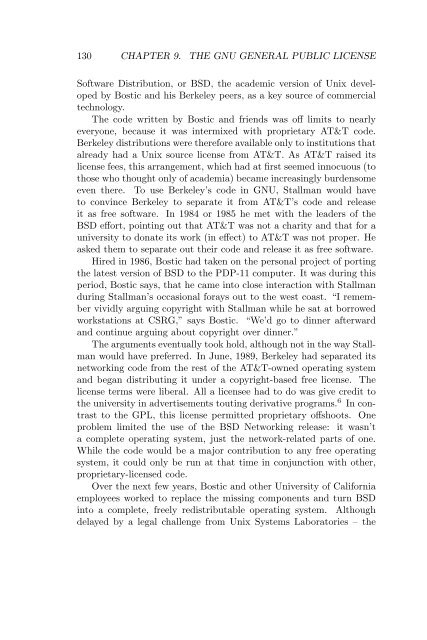You also want an ePaper? Increase the reach of your titles
YUMPU automatically turns print PDFs into web optimized ePapers that Google loves.
130 CHAPTER 9. THE GNU GENERAL PUBLIC LICENSE<br />
Software Distribution, or BSD, the academic version of Unix developed<br />
by Bostic and his Berkeley peers, as a key source of commercial<br />
technology.<br />
The code written by Bostic and friends was off limits to nearly<br />
everyone, because it was intermixed with proprietary AT&T code.<br />
Berkeley distributions were therefore available only to institutions that<br />
already had a Unix source license from AT&T. As AT&T raised its<br />
license fees, this arrangement, which had at first seemed innocuous (to<br />
those who thought only of academia) became increasingly burdensome<br />
even there. To use Berkeley’s code in GNU, Stallman would have<br />
to convince Berkeley to separate it from AT&T’s code and release<br />
it as free software. In 1984 or 1985 he met with the leaders of the<br />
BSD effort, pointing out that AT&T was not a charity and that for a<br />
university to donate its work (in effect) to AT&T was not proper. He<br />
asked them to separate out their code and release it as free software.<br />
Hired in 1986, Bostic had taken on the personal project of porting<br />
the latest version of BSD to the PDP-11 computer. It was during this<br />
period, Bostic says, that he came into close interaction with Stallman<br />
during Stallman’s occasional forays out to the west coast. “I remember<br />
vividly arguing copyright with Stallman while he sat at borrowed<br />
workstations at CSRG,” says Bostic. “We’d go to dinner afterward<br />
and continue arguing about copyright over dinner.”<br />
The arguments eventually took hold, although not in the way Stallman<br />
would have preferred. In June, 1989, Berkeley had separated its<br />
networking code from the rest of the AT&T-owned operating system<br />
and began distributing it under a copyright-based free license. The<br />
license terms were liberal. All a licensee had to do was give credit to<br />
the university in advertisements touting derivative programs. 6 In contrast<br />
to the GPL, this license permitted proprietary offshoots. One<br />
problem limited the use of the BSD Networking release: it wasn’t<br />
a complete operating system, just the network-related parts of one.<br />
While the code would be a major contribution to any free operating<br />
system, it could only be run at that time in conjunction with other,<br />
proprietary-licensed code.<br />
Over the next few years, Bostic and other University of California<br />
employees worked to replace the missing components and turn BSD<br />
into a complete, freely redistributable operating system. Although<br />
delayed by a legal challenge from Unix Systems Laboratories – the


